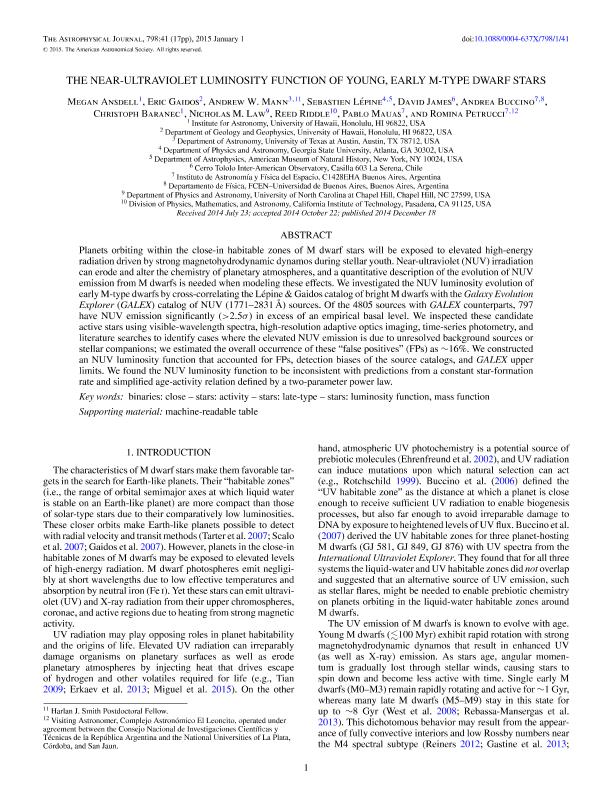Artículo
The near-ultraviolet luminosity function of young, early M-type dwarf stars
Ansdell, Megan; Gaidos, Eric; Mann, Andrew W.; Lépine, Sebastien; James, David; Buccino, Andrea Paola ; Baranec, Christoph; Law, Nicholas M.; Riddle, Reed; Mauas, Pablo Jacobo David
; Baranec, Christoph; Law, Nicholas M.; Riddle, Reed; Mauas, Pablo Jacobo David ; Petrucci, Romina Paola
; Petrucci, Romina Paola
 ; Baranec, Christoph; Law, Nicholas M.; Riddle, Reed; Mauas, Pablo Jacobo David
; Baranec, Christoph; Law, Nicholas M.; Riddle, Reed; Mauas, Pablo Jacobo David ; Petrucci, Romina Paola
; Petrucci, Romina Paola
Fecha de publicación:
01/2015
Editorial:
Iop Publishing
Revista:
Astrophysical Journal
ISSN:
0004-637X
Idioma:
Inglés
Tipo de recurso:
Artículo publicado
Clasificación temática:
Resumen
Planets orbiting within the close-in habitable zones of M dwarf stars will be exposed to elevated high-energy radiation driven by strong magneto-hydrodynamic dynamos during stellar youth. Near-ultraviolet (NUV) irradiation can erode and alter the chemistry of planetary atmospheres, and a quantitative description of the evolution of NUV emission from M dwarfs is needed when modeling these effects. We investigated the NUV luminosity evolution of early M-type dwarfs by cross-correlating the Lepine & Gaidos (2011) catalog of bright M dwarfs with the GALEX catalog of NUV (1771-2831 A) sources. Of the 4805 sources with GALEX counterparts, 797 have NUV emission signicantly (larger than 2.5 sigma) in excess of an empirical basal level. We inspected these candidate active stars using visible-wavelengthspectra, high-resolution adaptive optics imaging, time-series photometry, and literature searches to identify cases where the elevated NUV emission is due to unresolved background sources or stellar companions; we estimated the overall occurrence of these "false positives" as around 16%. We constructed a NUV luminosity function that accounted for false positives, detection biases of the source catalogs, and GALEX upper limits. We found the NUV luminosity function to be inconsistent with predictions from a constant star-formation rate and simplied age-activity relation defined by a two-parameter power law.
Archivos asociados
Licencia
Identificadores
Colecciones
Articulos(IAFE)
Articulos de INST.DE ASTRONOMIA Y FISICA DEL ESPACIO(I)
Articulos de INST.DE ASTRONOMIA Y FISICA DEL ESPACIO(I)
Citación
Ansdell, Megan; Gaidos, Eric; Mann, Andrew W.; Lépine, Sebastien; James, David; et al.; The near-ultraviolet luminosity function of young, early M-type dwarf stars; Iop Publishing; Astrophysical Journal; 798; 1; 1-2015; 1-17; 41
Compartir
Altmétricas



